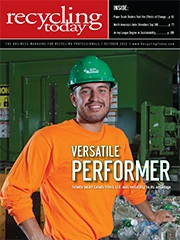|
|
The recycling chain of activity starts most often with collection—recognition that something is recyclable and it should not head to a landfill. Many of the next several steps after that involve transportation, a series of expenses that can determine to what extent the recycling endeavor will be profitable for someone. One of the more vigorous debates within the recycling industry during the past two decades has involved collection and transportation at the household level. Companies responsible for picking up and hauling recyclables in residential neighborhoods point to the benefits of single-stream collection. Having fewer trucks and drivers on the road, they say, allows them to pick up materials at a cost that can make the endeavor worthwhile and makes the act of bringing recyclables to the curb easier for homeowners. Single-stream collection was not hailed as an advance by everyone, however. Consumers of recyclables, paper mills in particular, decried the increased amount of contamination they witnessed in shipments, whether it was metal and crushed glass mixed into their loads of baled paper or banana peels and dirt. Momentum ultimately moved in favor of single-stream collection (at least here in the United States; in other countries the technique often has failed to gain adherents). The chances are good that if you brought bottles, cans and paper to a tree lawn this week, it was in a single-stream container headed to a material recovery facility (MRF). Waste Management Inc., as one of the giants in the residential collection and hauling industry, has been a proponent of single-stream collection and has endured its share of criticism from opponents of the method as a result. Recently, some have begun to wonder whether the company’s next step will be to combine garbage and recycling routes and haul material to mixed waste processing facilities (also known as “dirty MRFs”). In a recent presentation at the 2012 Solid Waste Association of North America (SWANA) Wastecon event, William Caesar, president of Houston-based Waste Management Recycle America, averred the company’s support for single-stream recycling collection but denied that operating “dirty MRFs” was the next step. Caesar described himself as “a proponent of single-stream,” but indicated he did not necessarily see an evolution toward mixed waste processing facilities. “There is still value in that first separation. Somebody pays me for that relatively clean commodity. I would rather maintain two truck routes because of the value of this relatively clean material.” Referring to additional source separation, Caesar added, “I don’t want to go to nine trucks, but I’ll keep two.” Volatility in the price of commodities, the rising cost of diesel fuel and changing collections (fewer newspapers, more plastics) are factors that have probably helped ensure single-stream maintains a place on the U.S. recycling stage. |
Get curated news on YOUR industry.
Enter your email to receive our newsletters.

Explore the October 2012 Issue
Check out more from this issue and find your next story to read.
Latest from Recycling Today
- Astera runs into NIMBY concerns in Colorado
- ReMA opposes European efforts seeking export restrictions for recyclables
- Fresh Perspective: Raj Bagaria
- Saica announces plans for second US site
- Update: Novelis produces first aluminum coil made fully from recycled end-of-life automotive scrap
- Aimplas doubles online course offerings
- Radius to be acquired by Toyota subsidiary
- Algoma EAF to start in April






